
The Kagyu school, also transliterated as Kagyü, or Kagyud, which translates to "Oral Lineage" or "Whispered Transmission" school, is one of the main schools of Tibetan Buddhism. The Kagyu lineages trace themselves back to the 11th century Indian Mahasiddhas Naropa, Maitripa and the yogini Niguma, via their student Marpa Lotsawa (1012–1097), who brought their teachings to Tibet. Marpa's student Milarepa was also an influential poet and teacher.

Tashi Lhunpo Monastery, founded in 1447 by the 1st Dalai Lama, is the traditional monastic seat of the Panchen Lama, and an historically and culturally important monastery originally in Shigatse, the second-largest city in Tibet.
Tertön is a term within Tibetan Buddhism meaning a person who is a discoverer of ancient hidden texts or terma. Many tertöns are considered to be incarnations of the twenty five main disciples of Padmasambhava, who foresaw a dark time in Tibet. He and his consort Yeshe Tsogyal hid teachings to be found in the future to benefit beings. A vast system of transmission lineages developed. Scriptures from the Nyingma school were updated by terma discoveries, and terma teachings have guided many Tibetan Bon and Buddhist practitioners.
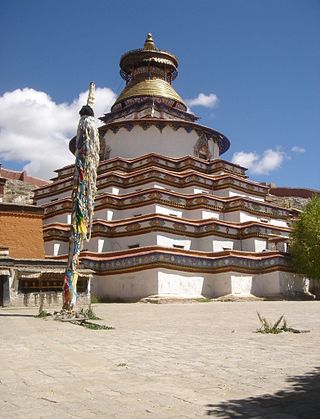
A Kumbum is a multi-storied aggregate of Buddhist chapels in Tibetan Buddhism. The most famous Kumbum forms part of Palcho Monastery.
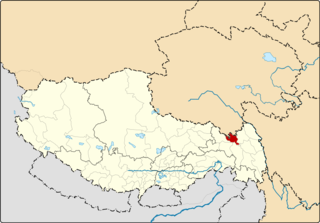
Riwoche is a county under the administration of the prefecture-level city of Chamdo in the Tibet Autonomous Region, China. The county lies in eastern Tibet and borders Qinghai province to the north.
The Taklung Kagyu is a sub-school of the Kagyu school of Tibetan Buddhism.

Ngamring County is a county of Xigazê in the Tibet Autonomous Region, China. "Ngamring County, sometimes referred to as the gateway to Mount Kailash and Far West Tibet, is the barren area which divides the Raga Tsangpo and the Brahmaputra."

The Tibetan Institute of Performing Arts (TIPA) was founded by Tenzin Gyatso, the 14th Dalai Lama on reaching McLeod Ganj, Himachal Pradesh, India in exile from Tibet in August 1959. It was then called Tibetan Music, Dance and Drama Society, which was one of the first institutes set up by the Dalai Lama, and was established to preserve Tibetan artistic heritage, especially opera, dance, and music.

Thangtong Gyalpo, also known as Chakzampa, the "Iron Bridge Maker", Tsöndrü Zangpo "Excellent Persistence", and the King of the Empty Plain. He was also known by a variation of this name, Madman of the Empty Valley. He was a great Buddhist adept, a Chöd master, yogi, physician, blacksmith, architect, and a pioneering civil engineer. He is considered a mind emanation of Padmasambhava and a reincarnation of Dolpopa Sherab Gyaltsen. He founded the Iron Chain lineage of the Shangpa Kagyu school of Tibetan Buddhism, and he recognized the first Samding Dorje Phagmo, Chökyi Drönma (1422–1455), the female incarnation lineage of Vajravārāhī.

Lhamo, or Ache Lhamo, is a classical secular theatre of Tibet with music and dance that has been performed for centuries, whose nearest western equivalent is opera. Performances have a narrative and simple dialogue interspersed with comedy and satire; characters wear colorful masks. The core stories of these theatrical plays are drawn mostly from ancient Indian Buddhist folk tales, lives of important people and historical events from Tibetan civilization. However the ceremonial, dance and ritual spectacles strongly reflects the Tibetan Royal Dynastic period.

Khenchen Palden Sherab Rinpoche, also known as "Khen Rinpoche," was a teacher, a scholar, a lama, and a Dzogchen master in the Nyingma school of Tibetan Buddhism. He was considered by Penor Rinpoche to be one of the most learned living Nyingma scholars. Palden Sherab founded the Orgyen Samye Chokhor Ling Nunnery, the first nunnery in Deer Park (Sarnath).

In Tibetan Buddhism, Vajravārāhī is a wrathful form of Vajrayogini associated particularly with the Cakrasaṃvara Tantra, where she is paired in yab-yum with the Heruka Cakrasaṃvara. Judith Simmer-Brown writes that "Vajravārāhī's iconography is very similar to that of Vajrayoginī, but she often has more prominent fangs and a more wrathful expression, and she prominently displays a sow's head above her right ear."
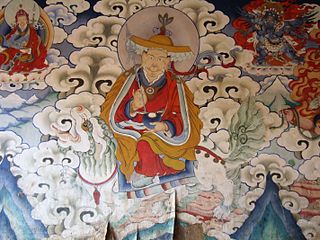
Gyalpo spirits are one of the eight classes of haughty gods and spirits in Tibetan mythology and religion. Gyalpo, a word which simply means "king" in the Tibetic languages, in Tibetan mythology is used to refer to the Four Heavenly Kings and especially to a class of spirits, both Buddhist and Bon, who may be either malevolent spirits or oath-bound as dharmapalas.

Taklung Monastery, Taklung stag-lung, Taklung Yarthang Monastery, Pel Taklug Tang or Taklung or Taglung Gompa is a Kagyu Buddhist monastery about 120 km north of Lhasa.

The Memorial Stupa, Thimphu, also known as the Thimphu Chorten, is a stupa in Thimphu, Bhutan, located on Doeboom Lam in the southern-central part of the city near the main roundabout and Indian military hospital. The stupa, built in 1974 to honor the third Druk Gyalpo, Jigme Dorji Wangchuck (1928–1972), is a prominent landmark in the city with its golden spires and bells. In 2008, it underwent extensive renovation. It is popularly known as "the most visible religious landmark in Bhutan". It was consecrated by Dudjom Jigdral Yeshe Dorje.
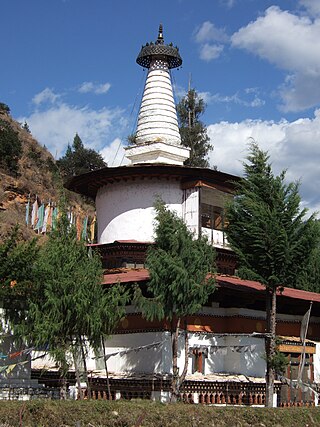
Jangtsa Dumgtseg Lhakhang[zlum brtshegs lha khang] is a Buddhist temple in western Bhutan. The temple is notable as it is in the form of a chorten, very rare in Bhutan. It is located on the edge of a hill between the Paro valley and the Dopchari valley, across the bridge from Paro. The Buddhist iconography depicted in the Chorten is considered a unique repository of the Drukpa Kagyu school.
Thangthong Dewachen Nunnery is a Buddhist monastery in the small Himalayan country of Bhutan. The nunnery is located in Zilukha overlooking Tashichodzong and is a few minutes’ drive from the town. It is popularly known as the Zilukha Anim Dratshang. It was built in 1976 by the 16th emanation of Thangtong Gyalpo, Drubthob Rikey Jadrel. Currently, the nunnery is home to about 60 nuns.

The Chushul Chakzam, or simply Chakzam which literally means "iron bridge" in Standard Tibetan, was a suspension bridge that spanned the Yarlung Tsangpo river in modern-day Qüxü County near Lhasa, Tibet. It was built in 1430 by Thang Tong Gyalpo. The southern bridgehead was built on the mountain Chowuri, which is sacred in Tibetan Buddhism. This mountain was a site where Guru Rinpoche and Trisong Detsen had meditated during the 8th Century. When it was built, its main section was the longest unsupported span in the world, with a central span estimated at around 150 yards.
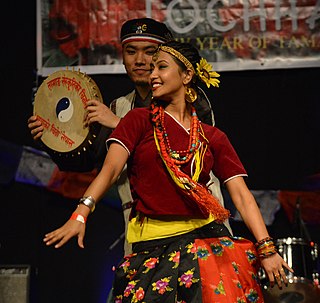
Sonam Lhosar is a New Year's day festival of the Hyolmo and Tamang people of Nepal as well as Sikkim and Darjeeling regions of India. It falls on the second new moon after the winter solstice which is usually the Magh Sukla Pratipada based on the eastern lunar calendar.
















